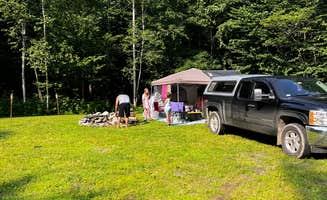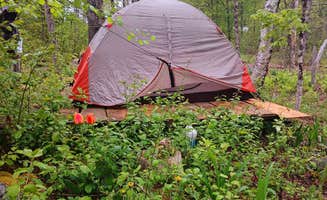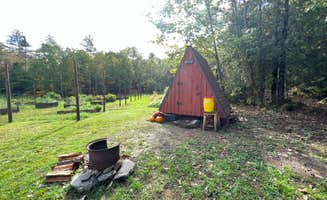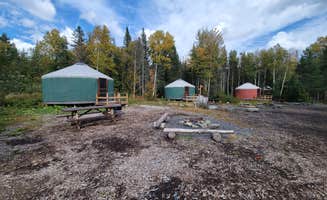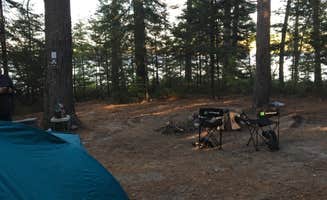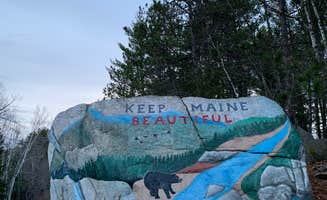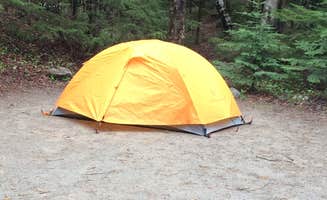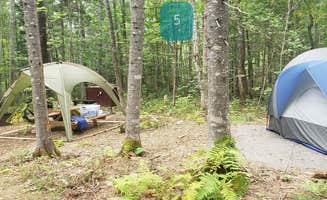Tent campsites near Medford, Maine stand among the state's most remote wilderness camping areas. The region sits at approximately 500-800 feet elevation within Maine's Hundred Mile Wilderness, a rugged section of the Appalachian Trail corridor. Winter temperatures frequently drop below zero, while summer nights often cool into the 40s even after warm days. Most primitive sites operate seasonally from May through October, with many closing after the first significant snowfall.
What to do
Paddle secluded ponds: Rum Pond Campsite offers an excellent base for exploring the 250-acre pond it borders. "The campsite is also accessible by water. About two tenths of a mile from the parking lot is a hand-carry launch and from there you can paddle to the campsite," notes camper Nancy W.
Hike nearby trail segments: The Appalachian Trail crosses through several camping areas. At Wilson Streams Area, "Take time to hike the falls trail which is a 2.4-mile round trip, out and back trail. The trail follows water with a few nice swimming holes and crosses the AT," according to Nancy W.
Wildlife viewing opportunities: Morning and evening hours provide the best wildlife spotting times. "We saw massive amounts of moose droppings along the trail near Cranberry Pond and did see a large bull moose at the small pond just off to the right-hand side as you enter Rum Pond Road from Ki Road," reports a camper at Rum Pond.
Swimming in natural pools: Several campsites offer swimming access. At Omaha Beach, "The water is also great for swimming. The three times I have camped here I've only seen one other group of people," shares Alexander T., highlighting the solitude available even during peak summer months.
What campers like
Privacy between sites: Many tent camping areas near Medford feature well-separated sites. At Big Pleasant Pond, "This area is one of the more popular locations and is relatively private with some distance between the two sites, though you can see each other if you're on the water," notes Jean C.
Waterfront camping options: Numerous sites offer direct water access. "Site 6 hugs the Abol stream providing beautiful scenery and the audible noise which suppresses sounds coming from other campers," describes Gavin T. at Abol Campground.
Access to backcountry fishing: Multiple campsites provide fishing opportunities. At Rum Pond Campsite, "The pond does have native brook trout so no live bait is allowed to be used," explains a reviewer, highlighting fishing regulations specific to this location.
Practical amenities: Despite the remote setting, some sites offer unexpected conveniences. "The bathrooms were immaculate! Great ranger!" reports Elizabeth P. about her stay at Katahdin Stream Campground.
What you should know
Road conditions vary significantly: Many forest roads require appropriate vehicles. At Omaha Beach, "BAD road - high clearance 4WD needed. Worth the drive!! Didn't see another person besides maintenance," warns Cindy D.
Permit requirements: Fire permits are mandatory in most locations. "A fire permit is required which you can inquire about by calling 207-695-3721. You are allowed to collect downed wood for fires but most of it is wet and unseasoned," explains a Rum Pond camper.
Fee structures differ by area: Maine's camping fees typically vary between residents and non-residents. At Johnston Pond, fees "are higher for out of state campers; rates are based off Maine minimum wage and campers pay both a day use and a camping fee per person, so the sites are not inexpensive."
Seasonal pest considerations: Black flies present significant challenges during early summer. "Blackflies are real y'all. And they are bad. Like Biblical-level," warns Lindsay B. about Abol Campground, suggesting avoiding May visits.
Tips for camping with families
Sheltered picnic areas: Some sites offer covered eating spaces valuable during rain. "[Big Pleasant Pond] sites provide a picnic table and fire ring; PP2 has a shelter over the picnic table," notes Jean C., identifying site features helpful for family camping.
Swimming safety: Rocky shorelines require water shoes at many locations. "PP2 also has a path to the pond with rocks on the shore of the clear water," describes a camper at Pleasant Pond, highlighting terrain considerations important for families with children.
Supply planning: Katahdin Stream Campground requires complete self-sufficiency. "Your last stop for food and gas is in Millinocket, so be sure to stock up before you make your way to the park. Millinocket is about 18 miles from the main entrance to Baxter State Park," advises Shari G.
Pet restrictions: Pet policies vary significantly between areas. "Dogs are not allowed in the park, but Katahdin Kritters is a pet boarding facility located in East Millinocket," notes a helpful reviewer about Baxter State Park regulations.
Tips from RVers
Size restrictions: Vehicle length limits apply throughout the region. At Johnston Pond in KIJO Mary Forest, "Be aware of general regulations for the KJM forest, including the need to yield to trucks (which are often moving at quite a clip and loaded with logs) and length limits (28' single vehicle, 44' combined)."
Limited facilities: Most primitive sites lack hookups entirely. Jean C. emphasizes at Big Pleasant Pond: "No drinking water, so bring your own or bring treatment. Pit latrine provided a short walk from the campsites."
Road navigation challenges: Forest roads require planning. "The roads are well-marked and if you pick up a map at the checkpoint, you should be ok finding your campsite. Consider also downloading maps for offline use as there is no cell coverage in most of the park," advises a Johnston Pond visitor.
Communication limitations: Cell service is minimal throughout the region. "You could sometimes get texts through from the nearby Little Jo Mary campsite area. I found my phone blew up with texts shortly after leaving the forest area, back on the main road," reports a camper about the digital disconnect in this wilderness area.


